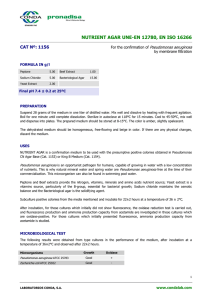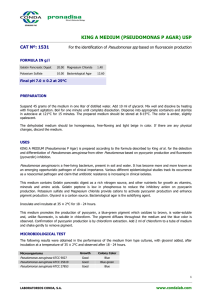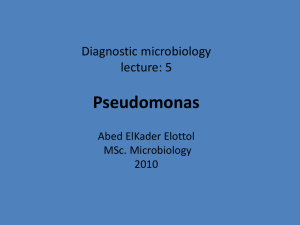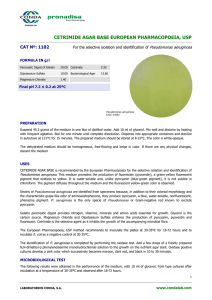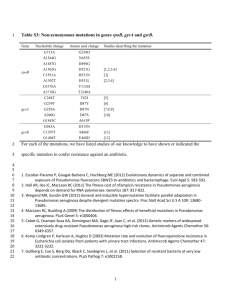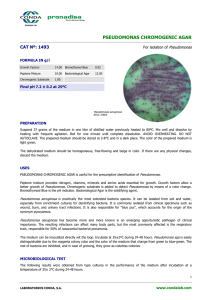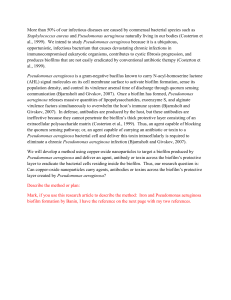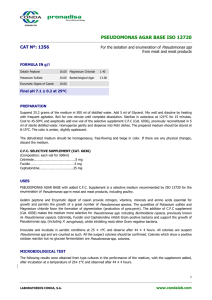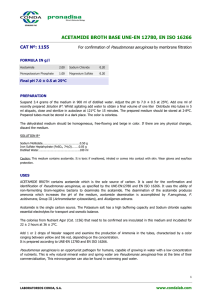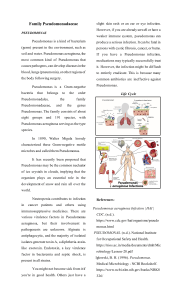PSEUDOMONAS
advertisement
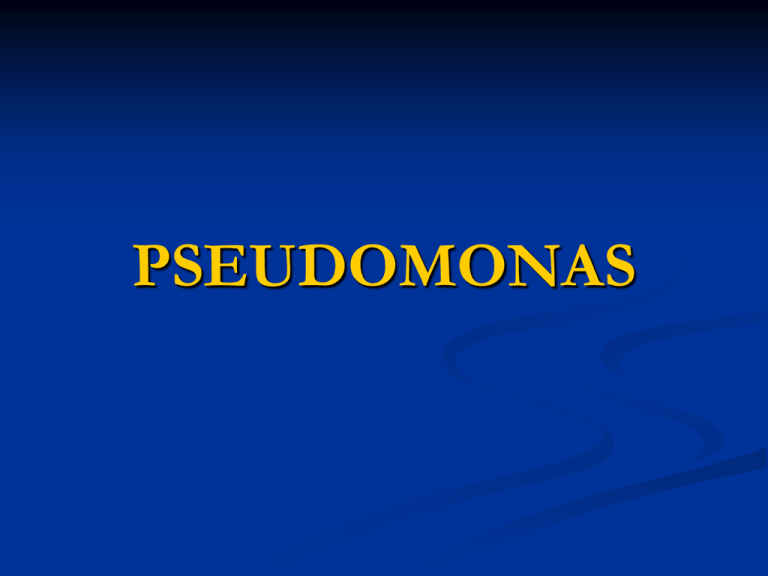
PSEUDOMONAS Pseudomonas aeruginosa Also known as burkholderia aeruginosa. Other species of pseudomonas are 1. Pseudomonas cepacia 2. Pseudomonas maltophilia 3. Pseudomonas pseudomallei Properties: 1. Pseudomonas is a gram negative rod with polar flagella 2. It is strict or obligate aerobe unlike the members of enterobacteriacea. Therefore it gets its energy through aerobic processes and not through fermentation. 3. It is lactose non fermenter Gram-stained Pseudomonas aeruginosa bacteria (pink-red rods). 4. Oxidase positive because contains high levels of cytochrome oxidase. 5. It can grow even in tap water with little amount of nutrients. 6. It can survive and multiply over a wide temperature range (20 to 42C) in almost any environment, including one with a high salt content. P. aeruginosa and cepacia have strong ability to withstand the disinfectants. This property also makes them commonest nosocomial organism. 8. Pseudomonas produces two pigments. a. Pyocanin. It gives a blue colour to the pus in wounds. b. Pyoverdin.( Flourescein). A yellow green pigment which flouresces under ultraviolet light. In lab these pigments impart agar a blue green colour P. aerugenosa synthesizes both pigments while others produce only pyoverdin. Epidemiology: The primary habitat of P. aeruginosa is the environment, chiefly found in soil and water. Also found in 10% people as normal flora of colon. Infections have resulted from the growth of Pseudomonas in medications, contact lens solutions, and even in some disinfectants. It is responsible for 10-20% nosocomial infections. Commonest cause of hospital acquired gram negative pneumonia. Pathogenesis: It mainly causes 1. Pneumonia. 2. UTI. 3. Sepsis in immunocompromized patients 4. Infections in burnt tissues. Pathogenecity is based on multiple virulence factors. 1. Endotoxins. Produce sepsis and septic shock. 2. Exotoxins. Two main exotoxins. a. Exotoxin A b. Exotoxin S or Exoenzyme S Exotoxin A is the best known. It produces tissue necrosis. Impairs protein synthesis of the cells. Exoenzyme S is produced by bacteria mainly in burnt tissues. It acts by damaging cytoskeleton. P. aeruginosa strains that posses type III secretion system are more virulent. Type III secretion systems work through pumps in the bacterial walls. ExoS is transported through this system. 3. Enzymes: Two enzymes a. b. Elastase. Alkaline Protease are important. They are toxic to tissues and facilitate the invasion of organism into the blood stream. Others include lecithinase and phospholipases. They appear to act together to break down lipids and lecithin. Clinical findings: It can cause infection any where in body but commonly it causes 1. UTI 2. Pneumonia 3. Infection in burn wounds. When disseminates it causes. 4. Sepsis 5. Necrotic skin lesions called eccthyma gangrenosum. 6. Also causes endocarditis in patients on I.V drugs use. 7. Severe external otitis ( malignant otittis externa) and folliculitis in persons using bath tubs and swimming pools. 8. Sever osteochondritis of foot 9. Corneal infections in contact lens users Lab diagnosis: 1. Gram staining. 2. Inoculation of nutrient agar 3. Inoculation of selective medium like Macconkey’s agar or EBM 4. Alkaline reaction on TSI agar 5. Oxidase test is positive 6. Fruity or grape like aroma P. aeruginosa isolates may produce three types of colony. 1. Natural isolates from soil or water produce a small, rough colony. 2. Clinical samples produce a colony with fried-egg appearance. Pseudomonas aeruginosa colonies on agar The soluble blue pigment pyocyanin is produced by many, but not all, strains of Pseudomonas Treatment: Resistant organism so treatment should be done according to C/S However drugs of choice are Ticarcillin or Piperacillin in combination with gentamicin or Amikacin
